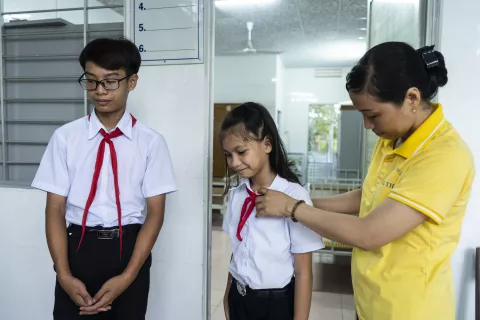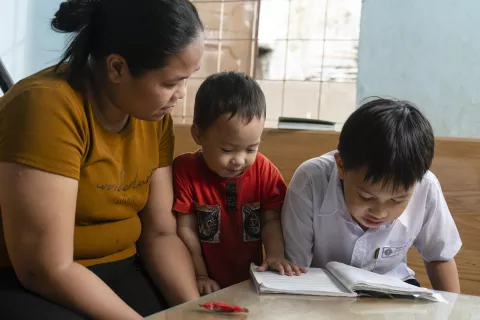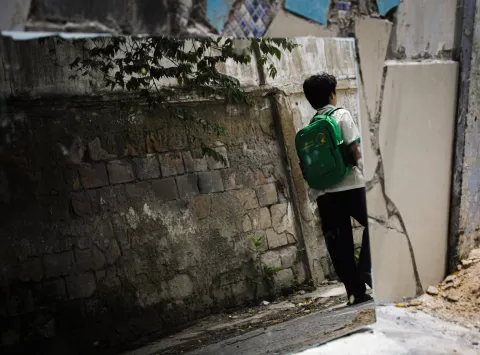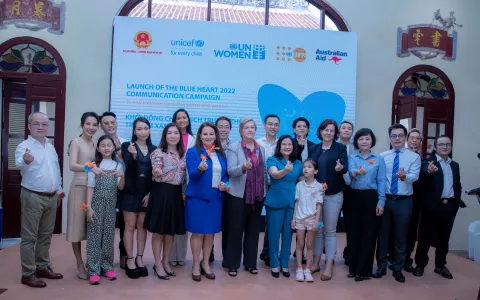Realizing the potential of children with disabilities
Modeling New Alternative Care Approaches for Children with Disabilities in Viet Nam

- Available in:
- English
- Tiếng Việt
Nine years old Ngo Diep Uyen is colouring a painting on the paper with great enjoyment. Although she cannot tell the difference between green, blue or red, she has made a great progress compared to two years ago before joining Hoa Vang Respite Day Care Centre for Children with Disabilities in Da Nang city of Viet Nam.
Uyen is mentally delayed. Her father left home when she was small. Her mother went to the city to look for a better job and Uyen has left in the care of her grandparents. Lacking the skill required to take care of a child with special needs, her grandparents did not know what to do as Uyen was so inactive. She did not talk, was lonely, never got out of the house and had no friends. “She needed stimulation and unfortunately we could not give that to her”, said her grandfather.
According to the Vietnamese Government, there are at least 1.3 million children with disabilities in Viet Nam. According to the 2009 Census, only 66.5 per cent of primary school-aged children with disabilities were attending school at the time of the survey, compared to 96.8 per cent of the national average. The literacy rate among persons with disabilities aged 15 to 24 years was 69.1 per cent, significantly lower than the rate for persons without disabilities (97.1 per cent). A 2004 study found that 54 per cent of children with disabilities reported to have no friends, and 29 per cent have few friends.
“Children who live with a physical, sensory, intellectual or mental health disability are among the most excluded of all the world’s children. Poor access to health, education and child protection services has put them at higher risk of violence, abuse and exploitation”. said Le Hong Loan, Head of UNICEF Viet Nam’s Child Protection Section.

Uyen has been attending Hoa Vang Respite Day Care Centre for Children with Disabilities since the first day of its inauguration. Waiting for the morning bus pickup has become her daily routine. She loves to go to the centre, where she can play and make new friends. In the centre, she can also learn useful things like how to dress, eat and wash herself on her own or exciting things like how to draw, sing and dance. She has changed completely only after a few months of learning at the Centre.
“She has started talking even though she only says a few words and is still lisping but she can communicate. She is cheerful all the time now. We feel so grateful for that”, said her grandfather.
In the same room at the Centre, seven year-old Nguyen Thi Tuyet Nhi is sitting with her peers, drawing. “I am making a drawing of my mother because I love her very much”, she says. Nhi is intellectually disabled. She joined the centre over a year ago.
“Nhi has made a lot of progress in very little time”, advises her teacher, Le Thi Ngoc Thao. “Before coming to the centre, she was not able to eat or clean her hands on her own. She was also very shy. Now she can speak out loud during class, also raise her hand when I call her name. She sings a lot of songs and is happy to take part in dance performances with other children”
Hoa Vang Centre for Children with Disabilities opened two years ago. Through this centre and two other centres in Da Nang, UNICEF is modeling a new approach to alternative care for children with disabilities. Most of the children in the centre – a total of 60 - are children with severe disabilities who are unable to go to regular schools. At the centre, they are able to socialize, acquire new skills, attend non-formal education classes tailored to their needs, and receive basic rehabilitation services. They come to the centre during the day on week days and return home in the evening. This allows parents to continue engaging in income-generating activities and ensure a nurturing environment for their children at home.
This centre besides provides a new model of alternative care, it also helps enhance the inclusion of children with disabilities within communities. This community-based day care model will help inform the government’s policies and strategies to prevent insitutionalisation and promote alternative care solutions not only for children with disabilities but also for other groups of at risk children.




